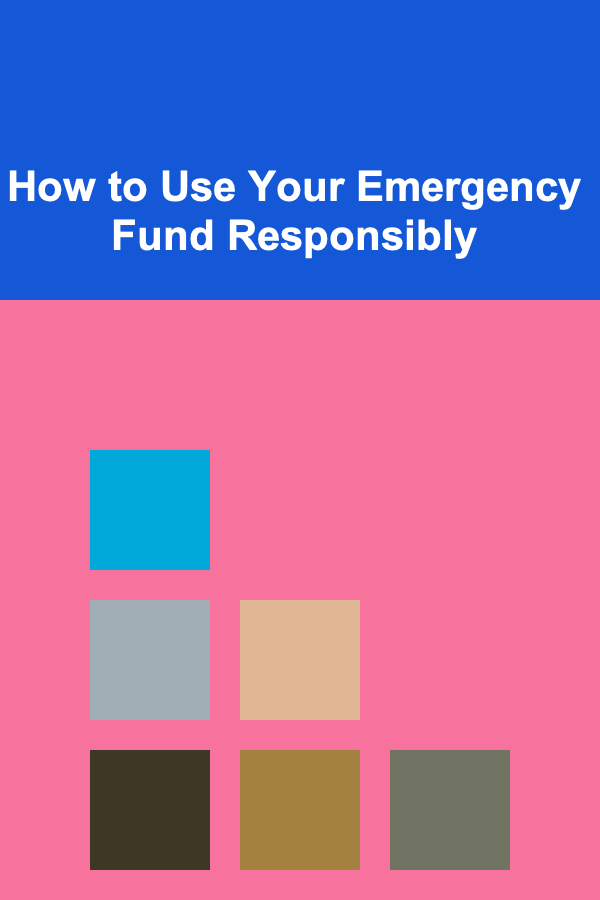
How to Use Your Emergency Fund Responsibly
ebook include PDF & Audio bundle (Micro Guide)
$12.99$9.99
Limited Time Offer! Order within the next:

An emergency fund is one of the fundamental pillars of personal financial stability. It is the financial cushion that protects you from unexpected situations like medical bills, car repairs, job loss, or urgent home maintenance. Without it, a sudden financial shock can lead to a debt spiral or force you to make poor financial decisions under pressure. However, simply having an emergency fund is not enough---knowing how to use it responsibly is equally crucial.
In this article, we will explore the importance of an emergency fund, when and how to use it wisely, and how to maintain its health. We will also look into the balance between preserving your emergency fund for true emergencies and avoiding misuse or over-reliance on it.
Understanding the Purpose of an Emergency Fund
Before diving into responsible usage, it's important to define the true purpose of an emergency fund. It serves as a financial safety net to cover unforeseen expenses that can derail your financial stability. These expenses typically arise from events that are both unpredictable and unavoidable. The primary reasons for having an emergency fund include:
- Financial Buffer Against Job Loss: If you lose your job or experience a reduction in income, an emergency fund can act as a buffer to cover living expenses until you secure new employment or other sources of income.
- Unexpected Medical Expenses: Healthcare costs, particularly in countries without universal health coverage, can be a major source of financial stress. An emergency fund provides peace of mind that you can pay for medical emergencies or urgent treatments.
- Home and Auto Repairs: Major household repairs, such as a broken furnace or water heater, or unplanned car breakdowns can quickly eat into your finances. Having an emergency fund allows you to handle these costs without disrupting your budget.
- Natural Disasters: Unforeseen events like floods, earthquakes, or fires may cause damage to your property. An emergency fund can cover immediate repair and relocation costs until insurance or other financial resources become available.
Setting Up an Emergency Fund
Before we explore the responsible use of an emergency fund, let's discuss how to set one up. Experts typically recommend saving three to six months' worth of living expenses. For example, if your monthly expenses amount to $3,000, your emergency fund should be between $9,000 and $18,000.
The exact amount can vary based on factors like:
- Job Security: If your income is unpredictable or if you're self-employed, you may want to save more to account for potential gaps in income.
- Family Obligations: Larger families or dependents may require a higher emergency fund to cover additional expenses.
- Insurance Coverage: If you already have comprehensive insurance that covers many emergencies, you might not need as much in your fund, but you should still have enough to handle deductibles or short-term gaps.
- Lifestyle Factors: If you have a more luxurious lifestyle with significant non-essential expenses, your emergency fund might need to be larger to maintain your standard of living in the event of a crisis.
Tips for Building an Emergency Fund:
- Start Small: If saving three to six months of expenses feels daunting, start by aiming for a smaller goal---like $1,000---and then gradually build up to your target.
- Automate Savings: Set up automatic transfers to your emergency fund each month so that saving becomes a habit. Even small amounts can add up over time.
- Cut Back on Unnecessary Spending: Look for areas where you can reduce discretionary spending to accelerate your emergency fund savings.
- Use Windfalls Wisely: Tax refunds, work bonuses, or unexpected cash gifts are great opportunities to bolster your emergency fund without affecting your regular budget.
When to Use Your Emergency Fund
Knowing when and why to dip into your emergency fund is crucial for its long-term sustainability. The key is to reserve this fund for true emergencies, not for non-urgent or discretionary expenses.
Genuine Emergencies:
- Medical Expenses: If you or a family member experience an unexpected illness or accident, medical costs may arise that are not covered by insurance. An emergency fund can help cover deductibles, co-pays, or the portion of the bill that insurance doesn't cover.
- Job Loss: If you lose your job, your emergency fund can replace lost income while you search for new employment. It's especially helpful if you're not eligible for unemployment benefits or if there is a gap in receiving severance pay.
- Urgent Home or Car Repairs: Major appliances breaking down, such as a furnace or refrigerator, or auto repairs like a blown engine are examples of emergencies. These are expenses that you can't defer for too long and need immediate attention.
- Natural Disasters or Emergencies: Floods, fires, or even minor accidents can result in unexpected costs. An emergency fund can help you cover repairs or temporary living expenses without relying on credit or loans.
Non-Emergencies:
Your emergency fund is not meant to cover planned expenses like vacations, weddings, or even the cost of upgrading a gadget. These are examples of non-emergency situations where using your emergency fund can disrupt your financial safety net and leave you vulnerable to future crises.
How to Use Your Emergency Fund Responsibly
To avoid depleting your emergency fund too quickly, it's essential to use it in a structured and responsible way. Here are some guidelines on how to make the most of your emergency fund:
a. Prioritize Urgent Needs Over Wants
Before dipping into your emergency fund, consider whether the expense is truly an emergency. Ask yourself:
- Is this expense necessary for survival, health, or safety?
- Can this expense be delayed or avoided without significant consequences?
- Would this cost lead to long-term financial harm if not addressed immediately?
By prioritizing your spending, you ensure that your emergency fund is used only for critical needs and not for wants.
b. Maintain Discipline
Once you tap into your emergency fund, it's crucial to replenish it as soon as possible. Set a goal to rebuild the fund within a set time frame (typically 6 to 12 months). Failing to replenish the fund can put you at risk of not having enough money when the next true emergency arises.
c. Limit Your Withdrawals
Try to minimize withdrawals from your emergency fund. If you find that you are consistently relying on it, it may indicate that your overall budget isn't sustainable. Look for ways to cut down on recurring non-essential expenses (e.g., eating out, subscription services) to avoid dipping into the fund for regular, predictable expenses.
d. Use Your Fund as a Last Resort
In the case of a financial crisis, use your emergency fund only after other options have been exhausted. For example, if you can delay payment on a bill or take on part-time work, do so. An emergency fund should only be used when no other reasonable option is available.
e. Don't Use Your Fund for Non-Emergencies
Avoid using your emergency fund for planned, non-emergency expenses, such as a vacation or purchasing a new car. While it's tempting to dip into your fund for lifestyle upgrades, this defeats the purpose of keeping it as a financial cushion for real emergencies.
How to Maintain Your Emergency Fund
Once your emergency fund is in place, maintaining it is equally important. Here are some strategies to ensure your emergency fund stays healthy:
a. Regularly Assess Your Needs
As your life circumstances change, so too will your financial needs. Review your emergency fund annually or after significant life events (e.g., marriage, children, buying a house) to ensure your fund is adequate for your current lifestyle.
b. Keep Your Fund Liquid
Your emergency fund should be easily accessible. Avoid investing it in high-risk assets that could fluctuate in value or are difficult to liquidate quickly. A high-yield savings account, money market account, or short-term certificate of deposit (CD) is an ideal place to keep your emergency fund.
c. Track Your Spending
Use budgeting apps or spreadsheets to monitor your expenses. If you notice that you are approaching your emergency fund limit or making frequent withdrawals, this could be an indicator that you need to reassess your financial habits.
What to Do if You Deplete Your Emergency Fund
Life can throw curveballs that may lead to using your entire emergency fund. If this happens, don't panic. Here are steps to take:
a. Reassess Your Budget
Look for areas where you can trim expenses. Create a plan to rebuild your emergency fund and stick to it. Cutting down on unnecessary purchases or adopting a more frugal lifestyle can help accelerate your savings process.
b. Build Small, Rebuild Gradually
If your emergency fund is depleted, try to rebuild it slowly by saving small amounts over time. Even setting aside $100 a month can gradually add up. The important thing is to start the rebuilding process as soon as possible.
Conclusion
An emergency fund is a crucial part of your financial toolkit, offering protection against the unexpected. However, it's equally important to use it responsibly. By ensuring that you save the right amount, use the fund for genuine emergencies, and maintain discipline, you can avoid misusing this critical resource. Always remember that an emergency fund is your safety net---use it wisely and keep it strong for when you truly need it.
Reading More From Our Other Websites
- [Hiking with Kids Tip 101] Top & Kid‑Friendly Hiking Apps Every Family Should Download
- [Home Lighting 101] How to Create Mood Lighting with Dimmers and Smart Controls
- [Tie-Dyeing Tip 101] Eco‑Friendly Tie‑Dye: Sustainable Fibers and Natural Dyes for a Greener Wardrobe
- [Personal Care Tips 101] How to Cope with Anxiety in the Workplace
- [Home Cleaning 101] How to Clean Your Home Before Moving In
- [Home Budget 101] How to Budget for Family Activities Without Overspending
- [Personal Finance Management 101] How to Save Money on Utilities and Lower Your Bills
- [Organization Tip 101] Why A Clean Garage Can Enhance Your Home's Curb Appeal
- [Skydiving Tip 101] Choosing the Right Drop Zone: How to Find the Perfect Skydiving Center for Beginners
- [Metal Stamping Tip 101] The Evolution of Metal Stamping Techniques for Energy‑Efficient Appliances

How to Groom Your Pet to Prevent Skin Issues
Read More
How to Organize a Family Volunteer Day at Home
Read More
How to Sell Digital Planners for Students: An Actionable Guide
Read More
How To Use Your Network for Personal Branding
Read More
How To Find Your First Remote Job: A Comprehensive Guide
Read More
How to Ace the Commercial Pilot Medical Exam
Read MoreOther Products

How to Groom Your Pet to Prevent Skin Issues
Read More
How to Organize a Family Volunteer Day at Home
Read More
How to Sell Digital Planners for Students: An Actionable Guide
Read More
How To Use Your Network for Personal Branding
Read More
How To Find Your First Remote Job: A Comprehensive Guide
Read More